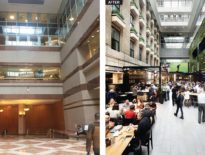
The Christian Science Plaza’s reflecting pool was rebuilt and waterproofed to halt leakage into the parking garage below. Photo courtesy of IBI Group
At 14 acres, The Christian Science Plaza is Boston’s largest publicly accessible private open space. Originally designed in 1968 by I.M. Pei & Partners’ Araldo Cossutta and Sasaki Associates’ Stu Dawson, the plaza is a national icon and a designated Boston Landmark.
The plaza was part of a mid-century update of the home of the worldwide Christian Science Church, The First Church of Christ, Scientist (TFCCS). Completed in 1972, it unites The Mother Church Original (1894), The Mother Church Extension (1906), the Publishing House and three Brutalist-style buildings by Araldo Cossutta into a single, monumental composition. Completed in 2021, this restoration and repair project is the Plaza’s first comprehensive restoration in nearly 50 years.
The renovations to the plaza and its beloved reflecting pool are more than a restoration effort. IBI Placemaking introduced new elements to achieve the client’s goals of enhanced social benefit and sustainability, while respecting the defining midcentury character. TFCCS wanted to make the Plaza more welcoming to the community and visitors. IBI Placemaking had to find ways to penetrate the plaza’s perimeter without compromising its historic integrity.
Inviting the Public Through Overlooked Gateways
To make the plaza more inviting, the design team added new entry signs at each of the three unmarked primary gateways. The Huntington Gateway involved shortening the 700-foot-long long reflecting pool by 16 feet to create a clear, accessible plaza entry. A fourth new gateway called “the Beach,” on the Huntington Avenue/Belvidere Street corner consists of a tilted lawn panel, granite seatwall, welcome signage and a break in an existing concrete wall that previously blocked plaza access. The gateway now accommodates a high volume of pedestrians by providing a direct path leading into the plaza, a notable improvement over the formerly shapeless and uninviting space.
To open the plaza to Huntington Avenue, the design team removed two raised planters, and added large wood platform benches for additional seating called “the Nooks.” Granite “carpets” in the Nooks shadow the former planters and allow the repetitive geometry to continue uninterrupted.
The team also overcame challenging technical issues to completely deconstruct, re-waterproof and reconstruct the monumental reflecting pool, which was leaking into the garage below. Design changes were incorporated to replace the reflecting pool’s concrete basin with a reflective dark granite that allows the pool to appear similarly reflective when empty as when full.
The original plaza design had few places to sit, and those that existed were uninviting. To add seating without clutter, the design team adapted existing elements for use as seating such as modifying the Massachusetts Avenue lawn’s original concrete curb into a concrete seatwall by enlarging the curb’s cross-section profile to seatwall proportions.
Adding Light and Warmth for Nighttime Experience
Along the Massachusetts Avenue edge, an unsettled line of 13 concrete platform benches beneath a row of mature red oaks were too fragile to reset without crumbling, so IBI Placemaking replaced them with wood platform benches in the exact same dimensions, to honor the original midcentury design intent while providing more warmth.

John Amodeo
To improve the nighttime experience, IBI Placemaking unified the many disparate light sources into a single warm LED source and refurbished the historic candelabra lampposts. To fill dark spots without adding more light poles, IBI Placemaking integrated lighting into building facades, seatwalls and the linden bosques.
The original spalling and slippery glazed brick paving required full replacement with a skid-resistant brick, maintaining original character while meeting safety and universal access codes.
Sustainable design measures include significant reduction in potable water consumption through pool improvements, and groundwater recharge through responsible management of stormwater runoff.
The Christian Science Plaza Restoration and Repair project extends the life of this historic open space into the next 50 years, adapting it to a new social context, keeping it relevant and vibrant. The new design elements respect the original design, while making the plaza more welcoming to all ages, in all seasons, in all times of day or night.
John Amodeo is a principal with IBI Group.




 |
| 

